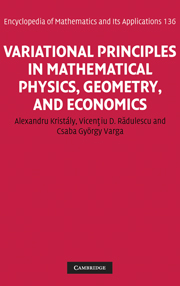 Variational Principles in Mathematical Physics, Geometry, and Economics
Variational Principles in Mathematical Physics, Geometry, and Economics Book contents
- Frontmatter
- Contents
- Foreword
- Preface
- Part I Variational principles in mathematical physics
- Part II Variational principles in geometry
- Part III Variational principles in economics
- Appendix A Elements of convex analysis
- Appendix B Function spaces
- Appendix C Category and genus
- Appendix D Clarke and Degiovanni gradients
- Appendix E Elements of set-valued analysis
- References
- Notation index
- Subject index
Preface
Published online by Cambridge University Press: 05 June 2013
- Frontmatter
- Contents
- Foreword
- Preface
- Part I Variational principles in mathematical physics
- Part II Variational principles in geometry
- Part III Variational principles in economics
- Appendix A Elements of convex analysis
- Appendix B Function spaces
- Appendix C Category and genus
- Appendix D Clarke and Degiovanni gradients
- Appendix E Elements of set-valued analysis
- References
- Notation index
- Subject index
Summary
For since the fabric of the universe is most perfect and the work of a most wise Creator, nothing at all takes place in the universe in which some rule of maximum or minimum does not appear.
Leonhard Euler (1707–1783)An understanding of nature is impossible without an understanding of the partial differential equations and variational principles that govern a large part of physics. That is why it is not surprising that nonlinear partial differential equations first arose from an interplay of physics and geometry. The roots of the calculus of variations go back to the seventeenth century. Indeed, Johann Bernoulli raised as a challenge the “brachistochrone problem” in 1696. The same year, Sir Isaac Newton heard of this problem and he found that he could not sleep until he had solved it. Having done so, he published the solution anonymously. Bernoulli, however, knew at once that the author of the solution was Newton and, in a famous remark asserted that he “recognized the Lion by the print of its paw” [224].
However, the modern calculus of variations appeared in the middle of the nineteenth century, as a basic tool in the qualitative analysis of models arising in physics. Indeed,
it was Riemann who aroused great interest in them [problems of the calculus of variations] by proving many interesting results in function theory by assuming Dirichlet's principle
(Charles B. Morrey Jr. [162])The characterization of phenomena by means of variational principles has been a cornerstone in the transition from classical to contemporary physics. Since the middle part of the twentieth century, the use of variational principles has developed into a range of tools for the study of nonlinear partial differential equations and many problems arising in applications. As stated by loffe and Tikhomirov [103],
- Type
- Chapter
- Information
- Variational Principles in Mathematical Physics, Geometry, and EconomicsQualitative Analysis of Nonlinear Equations and Unilateral Problems, pp. xii - xviPublisher: Cambridge University PressPrint publication year: 2010


